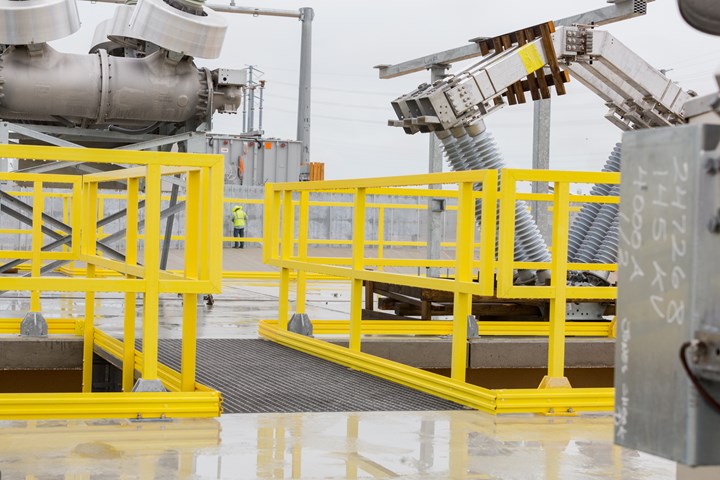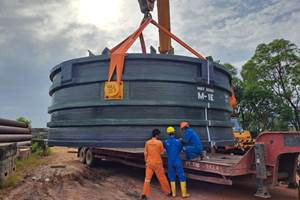Bedford Reinforced Plastics launches FRP structure line
Pre-engineered and prefabricated structures such as catwalks, walkways, fixed ladders and more can be combined for flexible configuration and minimal ongoing maintenance.

ReadyRail configuration. All photo credit: Bedford Reinforced Plastics
(Bedford, Pa., U.S.), a full-service supplier offering an extensive line of fiberglass-reinforced plastic (FRP) products and services, announced on April 13 the launch of , a quick-ship, easy-to-install modular solution to meet access and safety structure needs. ReadySeries is said to be the first modular system of this magnitude made of FRP.
Whether there is an area to climb or a space to span — or both — Bedford Reinforced Plastics says it can be handled quickly, safely and affordably with ReadySeries. The system includes industrial platforms, mezzanines, walkways, catwalks, fixed ladders, handrails, guardrails, stairs, stair towers, pedestrian bridges and more for far-reaching configurations. Each product can be used independently or can be combined with other products in the series.

ReadyStairs configuration. All photo credit: Bedford Reinforced Plastics
The company notes that industrial, pre-engineered and prefabricated structures only need to be bolted together with ordinary tools for easy installation. If on-site adjustments are needed, the FRP can be cut, drilled and assembled with standard tools. The material is strong yet lightweight to enable easier transportation and installation.
Bedford Reinforced Plastics notes that its ReadySeries products require minimal ongoing maintenance, hold up to corrosive environments, harsh weather and will not rust, rot or corrode. They are dimensionally stable, meaning components will not shrink, swell, warp or bow.
Further, the structures are OSHA compliant. Unlike wood and metal, the company says, ReadySeries FRP is fire-retardant, non-conductive and has low thermal conductivity to prevent expansion and contraction to keep structures stable. Anti-slip coatings minimize fall and slip risks. Safety yellow coloring is available in all relevant components.
ReadySeries products include:
- ReadyPlatform: Ideal for industrial access platforms, walkways, mezzanines and catwalk applications that don’t require a custom build. ReadyPlatform materials are available in 3 x 3-foot increments, and heights of 1-½, 3, 4-1/2 and 6 feet. Customers can also add ReadyStair, ReadyLadder or ReadyRail components to get their ideal configuration.
- ReadyRail: Guardrail and handrail materials that can be used on their own or to complement ReadyPlatform products. They’re stocked in 3-foot sections, and users are able to specify their railing run; Bedford will package all components into a handy kit.
- ReadyLadder: Customers can reportedly achieve the ladder height they need by combining sections available in 10-foot and 15-foot increments. Further, if needed, Bedford says customers can quickly trim one section with ordinary tools to get an exact fit or add a walk-through for a complete system.
- ReadyStair: Stair towers that can be adapt easily to almost any configurations. They fit in a 7-foot 5-1/4-inch x 12-foot 3/4-inch footprint, rising in 6-foot increments between landings. When needed, a short stretch of up or down stairs is provided for the final transition at the top. ReadyStair sections are also used in conjunction with ReadyPlatform materials to meet any configuration needed.
- ReadySpan: The high-strength ReadySpan bridge components are available for pedestrian, equestrian and light vehicle applications up to 100 feet long and 10 feet wide. Materials can be shipped in a kit to be assembled in the field, in modules that require limited assembly or completely assembled.
According to the company, the range of sizes, configuration versatility, seamless compatibility and durability of the ReadySeries line make it ideal for indoor and outdoor applications. Further, Bedford says operational savings and long-term reliability can be achieved.
Related Content
Composites end markets: Infrastructure and construction (2024)
Composites are increasingly used in applications like building facades, bridges, utility poles, wastewater treatment pipes, repair solutions and more.
Read MoreSGL Carbon carbon fiber enables German road bridge milestone
A 64-meter road bridge installed with carbon fiber reinforcement is said to feature a first in modern European bridge construction, in addition to reducing construction costs and CO2 emissions.
Read MoreComposite Braiding awarded for TPC twin track cantilever support
Railway infrastructure cuts weight by 84%, carbon emissions by 80% and installation time by 50% while automated process offers ≥90% lower labor costs, waste and energy use versus traditional composites manufacturing.
Read MoreRe-Wind Network completes first U.S. BladeBridge in Georgia
Beaverbrook Park now exhibits a 50-foot pedestrian bridge design consisting of a decommissioned wind blade flanked by two wooden decks.
Read MoreRead Next
Ultrasonic welding for in-space manufacturing of CFRTP
Agile Ultrasonics and NASA trial robotic-compatible carbon fiber-reinforced thermoplastic ultrasonic welding technology for space structures.
Read MoreNext-gen fan blades: Hybrid twin RTM, printed sensors, laser shock disassembly
MORPHO project demonstrates blade with 20% faster RTM cure cycle, uses AI-based monitoring for improved maintenance/life cycle management and proves laser shock disassembly for recycling.
Read MoreScaling up, optimizing the flax fiber composite camper
Greenlander’s Sherpa RV cab, which is largely constructed from flax fiber/bio-epoxy sandwich panels, nears commercial production readiness and next-generation scale-up.
Read More












